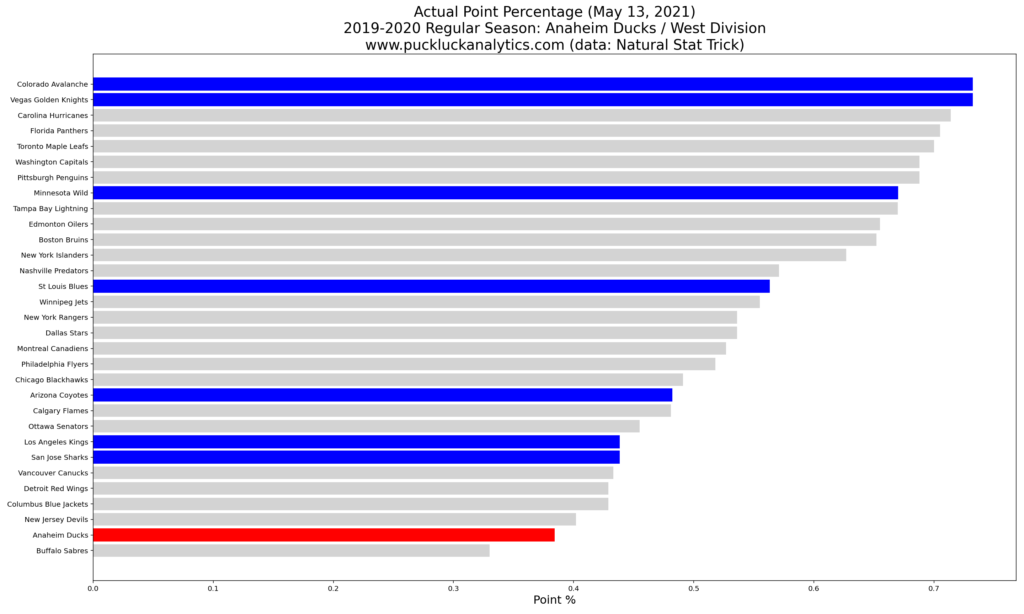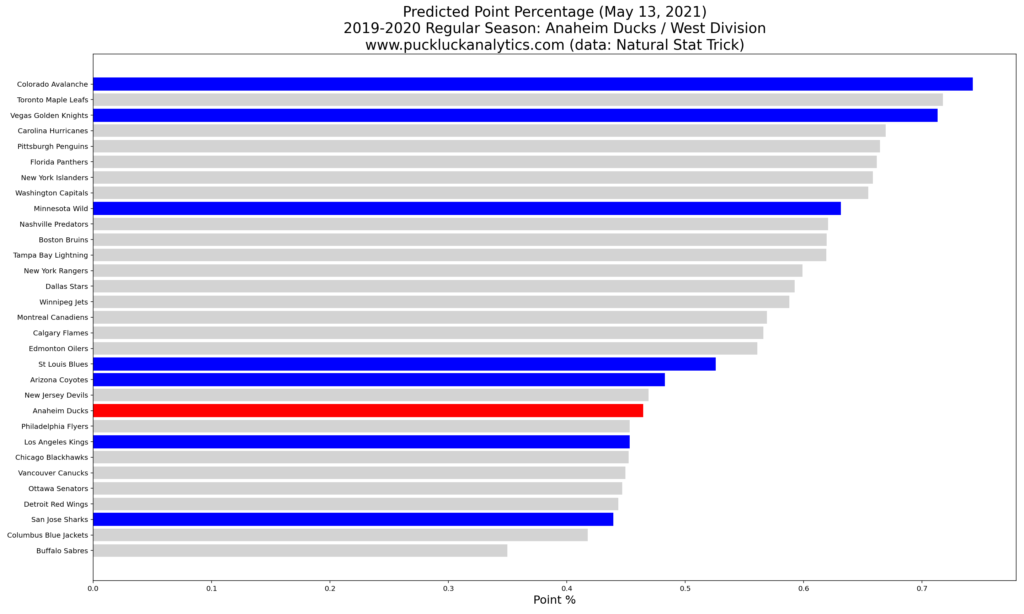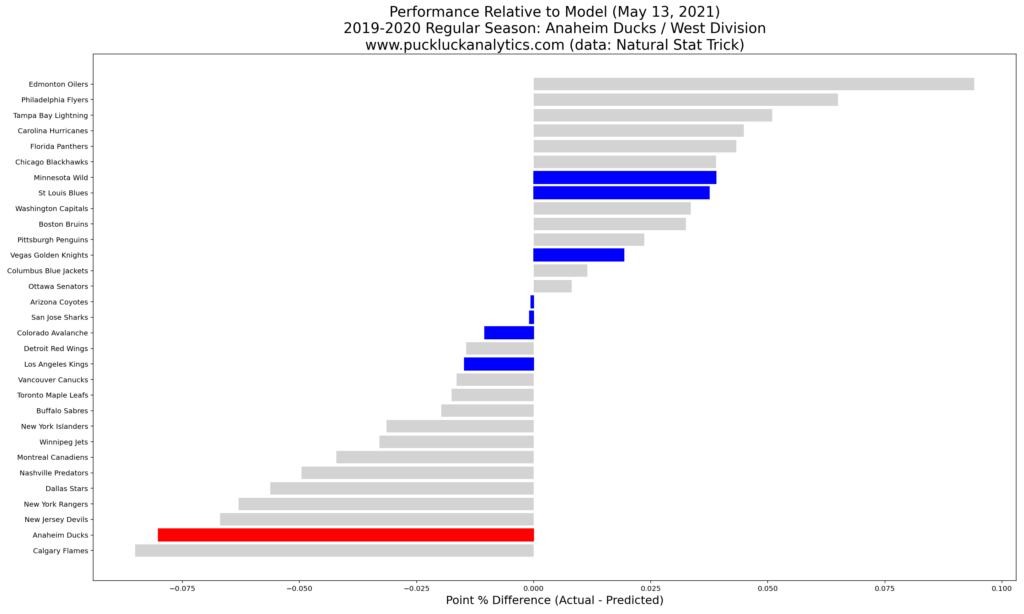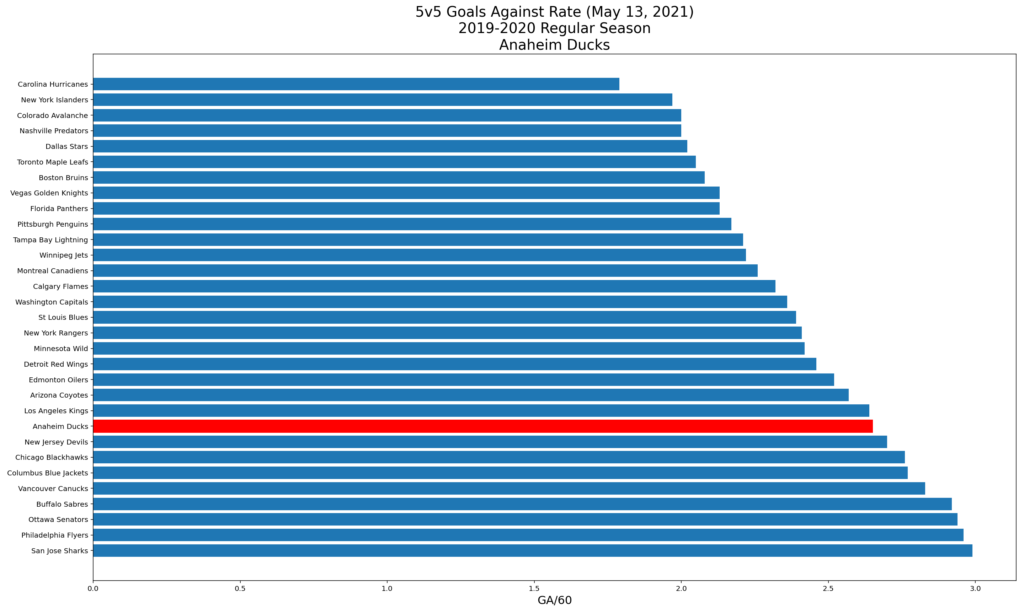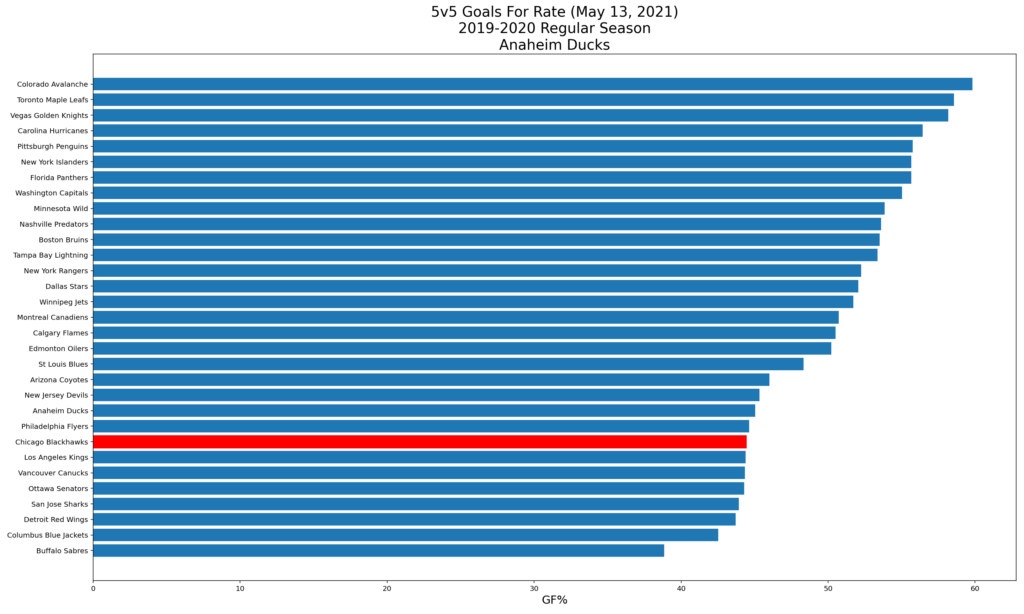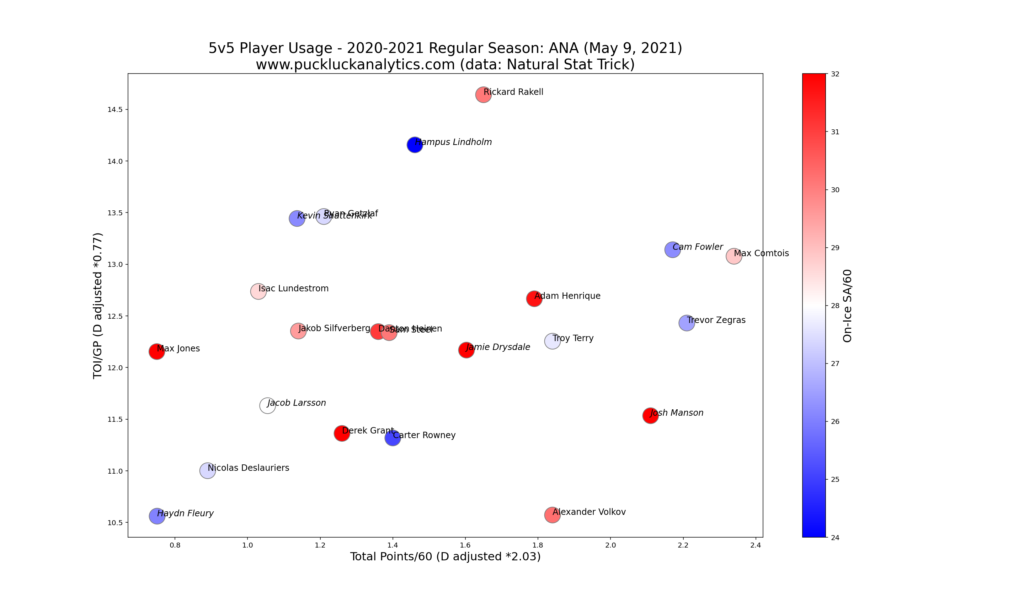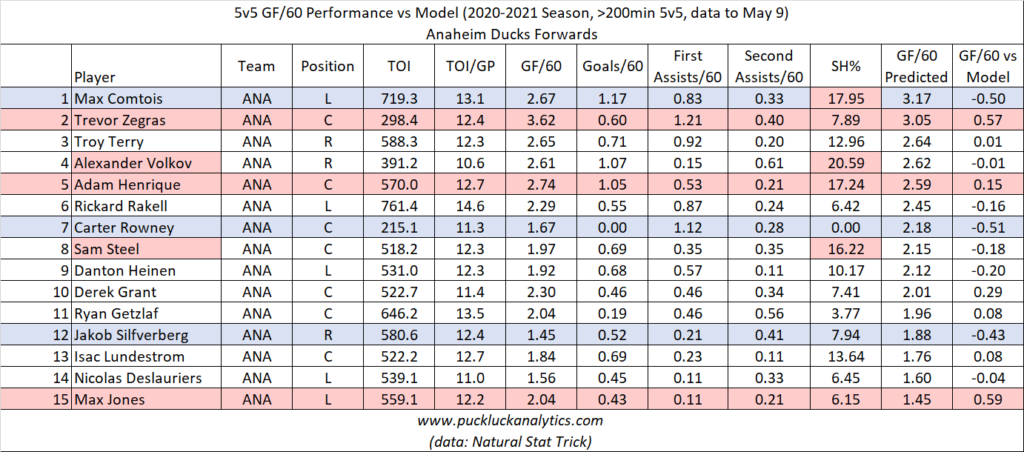With the West Division regular season games now wrapped up, the Anaheim Ducks are the third stop in my 2020-2021 season reviews. This post gives some additional info on what I’ll be looking for as I go through my review.
The West Division had a mix of some very strong teams and some very weak teams. While the Ducks fell into the latter group, there were some signs that they are headed in the right direction.
Overall Performance
Let’s start by looking at the Ducks overall performance in the standings and compare it to our point predictor model. The point predictor uses 5v5 goal rates as input and gives us some insight into how repeatable their performance was.
The Ducks finished last in the West and 30th overall, yet we see our model prediction puts them two positions higher in the West Division standings based on their 5 on 5 play. This suggests that some of the Ducks struggles this year were due to some factors outside of their 5 on 5 play, such as special teams performance and OT results. Since these types of events are more likely to vary from year to year, we expect the Ducks to have some improvement next season just by maintaining their 5 on 5 performance.
Let’s also look at the inputs used for the point predictor model, goals for rate, goals against rate, and goal for percentage.
Looking at the Ducks’ 5 on 5 goal rates, we see why our model expects them to have landed higher in the standings. Their goals against rate, ranked 23rd in the league, seems to be the largest factor. Their offense looks like it is close to competing, trailing the two teams that fought for the final playoff spot in the West (Arizona and St Louis) only slightly. If they can make progress on one or both of these numbers next season, they may be able to hang in the playoff race.
Player Performance
Shifting focus to player performance, we’ll start with a player usage chart to get a sense of the Ducks depth chart. Ideally, we’ll see a depth chart along the diagonal from top right to bottom left. Variation off the diagonal will give us an indication of issues with player usage or performance.
We see an interesting split on the plot. Players are distributed along two diagonal lines. Along the top line, we see some key veterans and players in their prime, such as Ryan Getzlaf and Hampus Lindholm. Along the lower line we see most of the Ducks young talent. The two lines indicate that the Ducks over-utilized their established veterans. This may be understandable in a rebuilding team if they were looking to shelter developing players from tough minutes but it’s something for us to keep in mind as we continue through our review.
Another secondary observation is the wide disparity in on-ice SA/60. There are a number of players with deep blue and deep red markers, indicating that the Ducks defensive play varied widely depending on the players on the ice. This is something that they need to improve in order to improve their overall GA/60.
Overall point production feeds into our GF/60 models. Let’s look at a visual depiction of each players overall 5v5 offensive impact by plotting their on-ice GF/60 vs TOI/GP before we get to the models.
Rookie Trevor Zegras jumps of the page on this chart. While it looks like his high on-ice GF/60 was likely helped by high on-ice SH%, he is still well above the rest of the team. Given a larger role and more ice time, he looks primed to become a key driver of the Ducks offense.
To the left of Zegras, another group of young forwards looks like they are ready to become larger contributors offensively as well. Sam Steel, Max Comtois, and Alexander Volkov all had strong GF/60 this season and may be ready for more ice time.
Among defensemen, Cam Fowler and Josh Manson had strong impacts offensively. Both look like they were boosted substantially by very high on-ice shooting percentage so we should cautious with future expectations.
Moving to defensive impact, on-ice SA/60 vs TOI gives us a visual indication of the relative defensive impacts of the skaters.
Hampus Lindholm is a standout on this chart. With the best on-ice SA/60 on the team and a lot of ice time, he had a large positive contribution to team defense. At the other end of the scale, Jamie Drysdale and Josh Manson also standout. These young defensemen struggled defensively and will need to develop the defensive side of their games before the Ducks thrust them into larger roles.
Among forwards, we see Ryan Getzlaf with a strong defensive impact. While his offensive production isn’t what it was a few years ago, he is still able to provide a steady two-way presence in the Ducks lineup. It’s also encouraging to see rookie Zegras as one of the better forwards on this chart.
Let’s move on to our GF/60 models. Large discrepancies between the model and actual results can give us an indication of which players may have been impacted significantly by their line mates. We’ll start with the forwards.
Max Comtois, Carter Rowney, and Jacok Siflverberg stand out as players who significantly underperformed the model. Comtois’s shooting percentage was very high and likely means our model prediction is too high. Rowney and Silfverberg, on the other hand, may be players that carried their lines offensively and could find success with larger roles.
On the flip side, Zegras, Adam Henrique, and Max Jones stand out as overperforming the model. This suggests they were carried offensively by their linemates. The Ducks would be wise to ensure these players are ready for the roles they are in. In Zegras’ case, while his offensive output suggests he could be given a larger role, some of his current success may be due to his linemates. Some additional time developing in his current role is probably a wise move before the Ducks look for him to carry his own line.
Things looks bright for the Ducks back end, with no players significantly overperforming the model and three significantly underperforming. This suggests that the Ducks defense is generally doing a good job of supporting the offense.
Finally, the future of goaltending looks relatively strong for the Ducks. John Gibson wasn’t outstanding this season, but was steady in net as the starting goaltender. While Ryan Miller had a great career, he struggled this season as the Ducks backups. However, with Miller’s retirement at the end of the season, Anthony Stolarz looks ready to step into the backup role next season. Based on this season’s numbers, he looks to be a good option for the Ducks.
Looking Ahead
The future looks bright in Anaheim and they have just shy of $59M committed against the cap for next season. Let’s take a look at some key players heading into the offseason.
Key RFAs:
Sam Steel and Max Comtois are both finishing their entry level deals. Both had strong relative impacts for the Ducks and the Ducks should look to lock up both this offseason.
Danton Heinen is also headed to the offseason as an RFA. His current deal carried a $2.8M cap hit. With similar offensive production to Steel, they Ducks should look to lock him up provide the cap hit is reasonable.
Key UFAs:
Ryan Getzlaf will head to unrestricted free agency this offseason. After a career as the face of the Ducks franchise, it’s likely that the two parties will want to get something done to keep him in Anaheim. With declining offensive production, the Ducks would be wise to keep the term short and the cap hit low enough that they have cap space available for their developing players.
Key Players Under Contract:
Trevor Zegras looked good in his limited number of games this season and he looks like he could be a key piece for the Ducks for years to come. The Ducks will be looking for continued growth from the 20 year old next season and he should become a full time NHLer.
Hampus Lindholm was the Ducks most impactful defenseman and has one year left on his deal with a $5.2M cap hit. He’ll be expected to anchor the Ducks defense again next season.
Tough Questions:
The Ducks need to decide when their target window to contend is. They have a group of players in their prime now along with a cohort of young developing players. Can they contend with the current core group (including Silfverburg, Rickard Rakell, Cam Fowler, Lindholm, Manson, and John Gibson)? Alternatively, should they switch focus to building a team around their younger players, such as Terry, Comtois, Zegras, and Drysdale?
As Ryan Getzlaf’s career winds down, the Ducks need to be careful that they don’t handcuff their cap situation with a large contract. While his leadership can certainly benefit a young Ducks team, the Ducks need to ensure that a deal with Getzlaf fits their long term needs.
While Josh Manson’s offensive production was great this season, we saw that he struggled on the defensive side of the puck. Is it time to move Manson and his $4.1M cap hit to get something in return before he becomes a UFA after next season?
Offseason Priority:
The Ducks could accelerate their rebuild by choosing the option to build around their younger players. This means moving some of their players in their prime to get additional assets to help the rebuild. There are plenty of teams ready to win now that would have interest in players such as Rakell, Fowler, and Lindholm and the Ducks could likely get some quality returns if they were to test the trade market. Adding a few more quality prospects to their current list of young players could make them a force in a few years.
Check out my previous reviews on the Blue Jackets and Sabres and subscribe to catch the rest of my season reviews as they come out.
data: Natural Stat Trick
cap Data: CapFriendly

